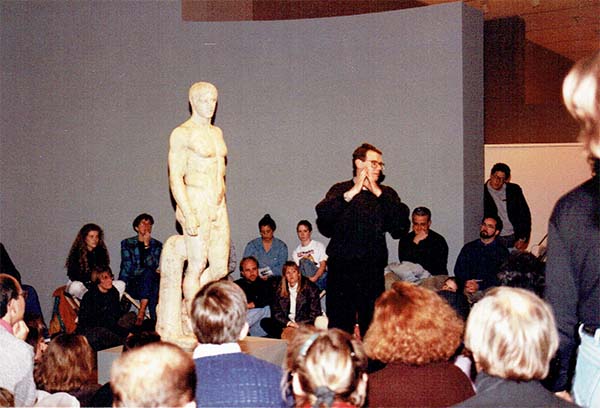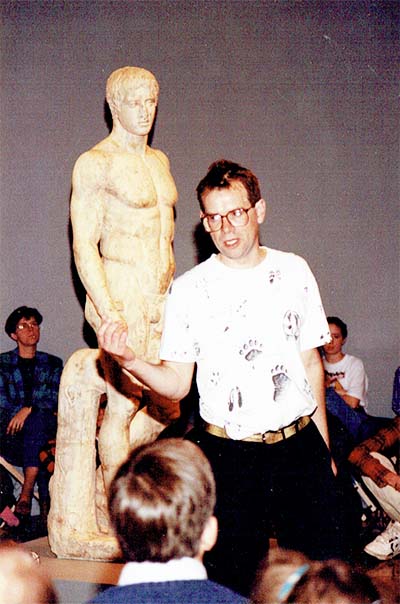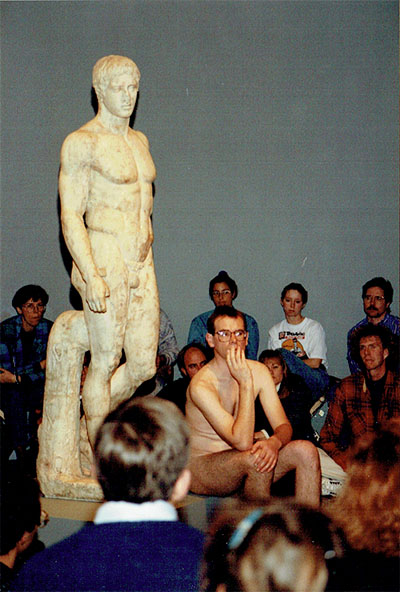THE SPEAR BEARER.
AN ESSAY BY GILES DENMARK ABOUT THE DORYPHOROS, BY POLYKLEITOS
The Spear Bearer. The Doryphoros. A man of our times. Times so reflective of Greece, 2400 years ago, when he was sculpted. He is 6 feet 6 inches tall, of superhuman size, especially considering the shortness of people at that time.
Some say he is an athlete, others Achilles, a god, and others an ideal man. He is man who would be God, a God who would be man.
He is a symbolic precursor of Christ - he is physically a trinity in himself. His head is designed to separate rules, ratios to the rest of the body, and is an aspiration to the power of mind over body - a sense of continuance of man beyond death, a sense of godliness. The rest of his body is contraposta or more exactly chlastic, a sort of yin yang, where one side of his body's tautness is reflected in a relaxed pose. Each element of body, arm, leg, hip is reflected in this way. The Doryphoros is an expression of godliness or immortality, resting on the spirit of energy that is man objectified in the tautness, and subjectified in the relaxed mode.

Giles Denmark performing Pursuing Perfection
Minneapolis Institute of Art, MN, USA
November 5 1992
The sculpture is one of the first renditions of man defined as a living breathing being. Of man seperate from the limitations of a stiff body, as accentuated by the Egyptians. Of man not limited in his reasoning of who he is within himself. Of man not held down by the schisms of the world. We catch the Doryphoros mid-breath, caught in time. The sculpture is an acceptance of time as a dimension. The pose that he stands in is near impossible, but also acceptable to our limited frames of reference. Polykleitos makes us aware of time held, between breath, between exertion and calmness. He suggests man as art. He suggests time base art. He suggests performance art.
The man is ideal. He based on strict ratios. He is built like a temple, each part adding up to the greater whole. He is superman. He has the body of a god. His individual identity is hidden, in the framing of muscle, of mathematics. He is the artist appearing as the performer. He is the artist appearing as a wish fulfillment. He is an object open for manipulation and knowledge. He is a sculptural rendition of man becoming performer. He emulates what we want of ourselves, as a mirror, or as a guide. Performance artists as shamans exert the same power, the same awareness, to guide their audience on to an understand the meanings of their world.
This man, this Doryphoros, sits at the apex of his world, of our world. He straddles time. He rides it, not showing us the way, but showing who we are. The dissolving of his form, the mannerisms that occured after his conception, mark the world we live in and will live in. He is both the epitome of classicism, and not. That is his strength. His sureness of ambiguity, of the chiastic system. The calmness, the separateness of his consciousness floating physically as well as symbolically above his body that is flesh and spirit. That again is his strength. He says 'To ere is to be human'. We have to accept that of ourselves, as well as accept our superb individuality and 'godlikeness'.


The Doryphoros, was sculpted by Polykleitos, and finished in bronze at the high point of the Greek Civilization. When Greece had won it's freedom by winning against the Persians at Marathon 490 B.C. and at Salamis 480 B.C.. When Pericles set about rebuilding the Acropolis. When man was considered at the centre of the universe. When the ideal man was both perfect body and perfect mind. When there was a sense of balance of control of the natural elements.
The Doryphoros of the Minneapolis Institute of Art has become something of a logo not only of the Institute but also of the city. In other ways its also a symbol of the USA, its values, and lack of values. Like every other rendition in the world it is a Roman copy. It's a borrowed Bible. It is a siezed item of power, a cannibalistic swallowing of another's heart, to make him strong, to make him have the same ideals (at least on the surface). It is an altar that we go to gain spirit and nourishment. It is promoted as the best example of Roman Sculpture in America. It is considered a prize. And as viewers we are indeed lucky to have it here to draw wisdom from.
What is seen? What is not? It is exhibited isolated, in a specially designed alcove. It is another work in the collection of prized trophies, that we as hunters have tracked down and paid for. Yet also it is given pride of place, set off by itself. It cost more than 2 million dollars to purchase. Paid for by benefactors who want to improve our lot. So how is it approached in this chapel cut into the antiquities galleries. We enter the firm walls, doors of this defined classic building, not unlike the Acropolis. We go through the laid back security (emtrance is free), for we are luckilly courted in this established institution, seduced to play its game, run its games, know that it reflects the laws of the city. It is indeed the Temple of the City. It is the Acropolis. We are entering the church of man.
The Doryphoros is placed on the second floor of the Minneapolis Institute of Arts. We go to it climbing stairs. Passing other representations of ideals, created by other cultures, other times, other artists. Each work contests for space in the ordering of things in our minds. Each work pegs its way into symbolic relationships, metaphors, emotional stories that are in ourselves. The Institute, (or The Temple of Man), helps to make all acceptable.
So finally we are face to face with The Doryphoros. A copy of the Doryphoros. By sculptor unknown (it could be by an illustrious Roman artist called Appolonius but its not really important). We are lucky to be to have direct contact with what amounts to be a myth. A sculpture that is based on another sculpture that does no longer exist. A sculpture created by a sculptor, working from what he knows, and breathing it into his desires, his feelings, for what he perceives man to be. Even the ravages of time, the sculpture's episodes of being lost on an ocean floor, or in the ground, under where grapes might have grown, have not lost the breath that exudes making this man, this spear bearer, more than just a series of mathematical relationships, morem than a copy using exacting methods of copying. We are in touch with the myth. It accesses into our space. Our comprehension of the world of rap music and drug wars, of computers and video. How has it? And how has it been manipulated?
Giles Denmark wrote this in 1992 when he was living in Minneapolis. In that year he had a Mcknight fellowship, and had performed locally, as well as across USA and in Europe. A multi-disciplinary artist he also works in writing, video, computer arts, photography, environment installations, painting, music, and poetry. He now lives in France.
Pursuing Perfection - the Doryphoros - Main Page
giles denmark creates
POETRY PAINTINGS MURALS INSTALLATIONS PERFORMANCE ART THEATRE MUSIC SOUND-SCULPTURES



